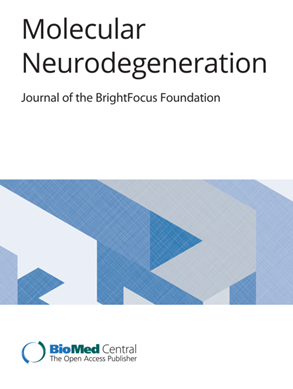APOE4和AD中溶酶体ABCA1介导胆固醇积累引起的细胞衰老
IF 17.5
1区 医学
Q1 NEUROSCIENCES
引用次数: 0
摘要
细胞衰老,衰老的标志,已牵连到阿尔茨海默病(AD)的发病机制。众所周知,胆固醇的积累会导致细胞衰老;然而,其潜在机制尚不完全清楚。atp结合盒转运蛋白A1 (ABCA1)在胆固醇稳态中起重要作用,其表达和转运在APOE4和AD模型中发生改变。然而,ABCA1在APOE4和AD相关的细胞衰老中的作用尚不清楚。我们通过转录组学、组织学和生化分析研究了人类死后脑样本中细胞衰老和ABCA1表达之间的关系。进行无偏蛋白质组学筛选以鉴定介导细胞ABCA1运输的蛋白质。我们创建了ABCA1敲除细胞系和小鼠模型,以验证ABCA1在胆固醇诱导的mTORC1激活和衰老中的作用。此外,我们使用APOE4-TR小鼠和诱导多能干细胞(iPSC)模型来探索胆固醇- abca1衰老途径。来自宗教秩序研究/记忆衰老项目(ROSMAP)队列的人类背外侧前额叶皮层转录组分析显示,AD患者细胞衰老转录组特征上调,这与ABCA1表达和氧甾醇水平相关。免疫荧光和免疫印迹分析证实,AD脑中脂褐素染色的脂质和ABCA1表达增加,并与mTOR磷酸化有关。发现蛋白质组学鉴定出细胞胆固醇积累的传感器小窝蛋白-1是ABCA1内溶酶体运输的关键启动子。APOE4-TR小鼠模型和AD人脑中观察到更大的caveolin-1表达。氧化甾醇诱导的mTORC1活化和衰老受ABCA1溶酶体诱捕的调控。用环糊精治疗APOE4-TR小鼠可降低脑内氧甾醇水平、ABCA1溶酶体捕获、mTORC1激活,并减轻衰老和神经炎症标志物。在人类ipsc衍生的星形胶质细胞中,环糊精降低胆固醇可减轻炎症反应。APOE4和AD中的氧甾醇积累诱导ABCA1和caveolin-1表达,导致溶酶体功能障碍和细胞衰老标志物增加。本研究为胆固醇代谢如何加速脑细胞衰老途径的特征提供了新的见解,并确定了缓解这些过程的治疗靶点。本文章由计算机程序翻译,如有差异,请以英文原文为准。
Cellular senescence induced by cholesterol accumulation is mediated by lysosomal ABCA1 in APOE4 and AD
Cellular senescence, a hallmark of aging, has been implicated in Alzheimer’s disease (AD) pathogenesis. Cholesterol accumulation is known to drive cellular senescence; however, its underlying mechanisms are not fully understood. ATP-binding cassette transporter A1 (ABCA1) plays an important role in cholesterol homeostasis, and its expression and trafficking are altered in APOE4 and AD models. However, the role of ABCA1 trafficking in cellular senescence associated with APOE4 and AD remains unclear. We examined the association between cellular senescence and ABCA1 expression in human postmortem brain samples using transcriptomic, histological, and biochemical analyses. Unbiased proteomic screening was performed to identify the proteins that mediate cellular ABCA1 trafficking. We created ABCA1 knock out cell lines and mouse models to validate the role of ABCA1 in cholesterol-induced mTORC1 activation and senescence. Additionally, we used APOE4-TR mice and induced pluripotent stem cell (iPSC) models to explore cholesterol-ABCA1-senescence pathways. Transcriptomic profiling of the human dorsolateral prefrontal cortex from the Religious Order Study/Memory Aging Project (ROSMAP) cohort revealed the upregulation of cellular senescence transcriptome signatures in AD, which correlated with ABCA1 expression and oxysterol levels. Immunofluorescence and immunoblotting analyses confirmed increased lipofuscin-stained lipids and ABCA1 expression in AD brains and an association with mTOR phosphorylation. Discovery proteomics identified caveolin-1, a sensor of cellular cholesterol accumulation, as a key promoter of ABCA1 endolysosomal trafficking. Greater caveolin-1 expression was observed in APOE4-TR mouse models and AD human brains. Oxysterol induced mTORC1 activation and senescence were regulated by ABCA1 lysosomal trapping. Treatment of APOE4-TR mice with cyclodextrin reduced brain oxysterol levels, ABCA1 lysosome trapping, mTORC1 activation, and attenuated senescence and neuroinflammation markers. In human iPSC-derived astrocytes, the reduction of cholesterol by cyclodextrin attenuated inflammatory responses. Oxysterol accumulation in APOE4 and AD induced ABCA1 and caveolin-1 expression, contributing to lysosomal dysfunction and increased cellular senescence markers. This study provides novel insights into how cholesterol metabolism accelerates features of brain cellular senescence pathway and identifies therapeutic targets to mitigate these processes.
求助全文
通过发布文献求助,成功后即可免费获取论文全文。
去求助
来源期刊

Molecular Neurodegeneration
医学-神经科学
CiteScore
23.00
自引率
4.60%
发文量
78
审稿时长
6-12 weeks
期刊介绍:
Molecular Neurodegeneration, an open-access, peer-reviewed journal, comprehensively covers neurodegeneration research at the molecular and cellular levels.
Neurodegenerative diseases, such as Alzheimer's, Parkinson's, Huntington's, and prion diseases, fall under its purview. These disorders, often linked to advanced aging and characterized by varying degrees of dementia, pose a significant public health concern with the growing aging population. Recent strides in understanding the molecular and cellular mechanisms of these neurodegenerative disorders offer valuable insights into their pathogenesis.
 求助内容:
求助内容: 应助结果提醒方式:
应助结果提醒方式:


